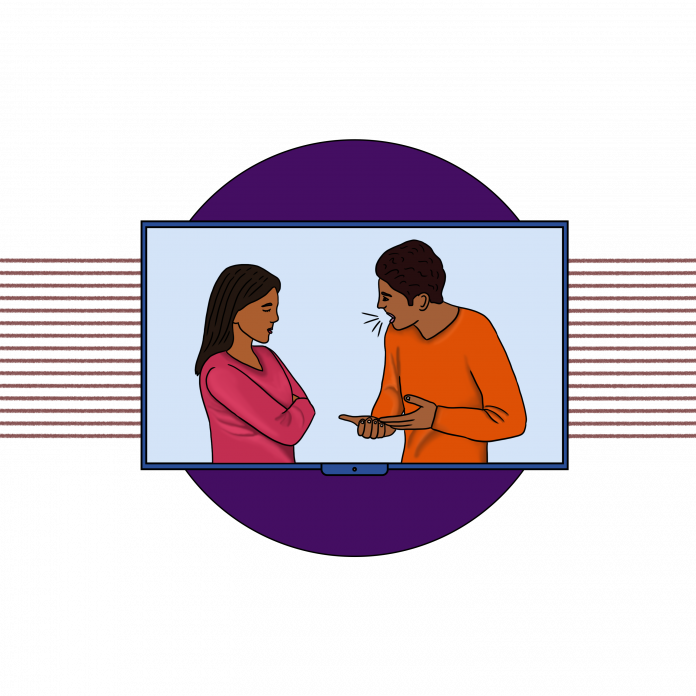By Mehwish Batool
Drama Serial Ye Dil Mera – Episode 27: Neelofer (played by Mira Sethi) confronts her husband Mir Farooq Zaman (played by Adnan Siddiqui) about a crime he has committed. He pushed her towards the wall, slapped her, took out his belt and dragged her into the room. Their little daughter, who is sleeping in an adjacent room, hears the screams of her mother who is being whipped with a belt. She gets scared. We, the viewers, get equally scared at the degree of violence that we have just witnessed on the television screen.
Drama serial Bebasi – Episode 6: Tameezuddin (played by Waseem Abbas) is having an altercation with his two daughters and wife Ishrat (played by Shaugufta Ijaz). He gets up to hit one of the daughters. The mother forces them out of the room and the next thing we know is that the father is beating up the mother ruthlessly. He is punching her in the face and scolding her. Later, we can see her bedridden with bruises all over her face. We wonder what the need was to show the act of brutality with such detail!
Drama serial Fitoor – Episode 31: During a confrontational scene, Haider (played by Faisal Qureshi) slaps his wife Dilnasheen (played by Hiba Bukhari) and exclaims; “Ye thappar tumharay gaal par zaror para he lekin tumharay lafz teer ki tarah mere dil par lagay hain” “The slap might have hit you hard, but your words have hit my heart like arrows.” Again, we are left flabbergasted at how casually the “hero of the play” has raised his hand on a woman that he supposedly loves.
Welcome to the world of Pakistan’s television drama where violence is the norm, not an exception.
It really doesn’t matter which age or socio-economic status you belong to, if you are a female protagonist in a Pakistani drama, you are bound to be slapped by your husband, father, brother, or another woman. Apart from showing slaps and physical violence, there are so many instances where women are harassed, sexually abused, and psychologically tortured that leave us questioning what has gone wrong with our drama writers and producers.
Overdose of slapping scenes:
Over the years, television dramas have remained one the most popular sources of entertainment in Pakistan. Our dramas have gained recognition all over the world because of their powerful storylines and iconic characters. However, in recent years, there has been an increased focus on adding sensationalism in the storylines. In order to get higher TRPs, channel owners and drama makers have abandoned the art of subtlety in favor of melodrama. So instead of having progressive stories featuring headstrong and empowered women, we now see stereotypical portrayal of women and gender minorities on our TV screens. Showing gender-based violence has become a trend in our dramas and its effects can be seen in the real world as well.
Hum Kahan Ke Schay Thay is one of the highest rated dramas in recent times starring top stars such as Mahira Khan, Kubra Khan and Usman Mukhtar. The drama features a regressive storyline where a husband is shown to emotionally abuse his wife. In one of the scenes, he even raises his hand to scare her. Not just him, both the women protagonists have also slapped each other in the drama on different occasions. The makers of the drama have received criticism for normalizing violence and romanticizing domestic abuse. Kanwal Ahmed, founder of a popular Facebook forum Soul Sisters Pakistan, has called out Mahira Khan for her problematic selection of characters that glorify abusive relationships. Ironically, Mahira Khan is the UNHCR National Goodwill Ambassador, and has recently promoted a campaign to raise public awareness against domestic & sexual violence.
Embed Kanwal Ahmed’s tweet:
Another blockbuster play in recent times, Khuda Aur Mohabbat 3, was heavily criticized for glorifying harassment and violence. In one scene, Nazim Shah (played by Sohail Sameer) was shown slapping his wife Sahiba (played by Sunita Marshal). PPP politician Sharmila Faruqui took to Instagram to condemn this scene and raised a valid question that why do our women have to face violence and abuse at the drop of a hat.
Embed Sharmila Fauqui’s insta post:
The ground reality:
In Pakistan, where gender-based violence is one of the major human rights concerns, the obsession of drama makers to show acts of violence against women is appalling. A large body of research supports that Pakistani women experience some form of abuse on a day-to-day basis. In the first half of the year 2021, a total of 3721 cases of violence against women were registered only in Punjab and ICT, as reported by SSDO. In 2020, a total of 9401 cases were reported out of which the media tracked only 1409 cases. But these numbers don’t reflect a complete picture. In Pakistan, most of the cases of violence go unreported as women don’t come out due to societal pressure, flawed complaint structures and fear of their lives. The brutal murders of Qurat-ul-Ain in Hyderabad and Noor Mukadam in Islamabad are just a few cases that have made it to the media. There are countless other stories where women are abused physically, sexually and emotionally. One can’t imagine the plight of such women who suffer silently. Instead of giving them hope and strength, our dramas give them more despair.
There is no denying the fact that the media holds a mirror to society. While violence against women is an unfortunate reality in present-day Pakistan; media should be extra vigilant in portraying such themes. When you repeatedly show a woman getting slapped or tortured in a drama, you will end up desensitizing viewers. In most of these dramas, men don’t even face any consequences for their act of violence. Dilnasheen goes back to Haider in the climax of Fitoor and Sahiba continues to be with Nazim Shah in Khuda and Mohabbat as if nothing has happened. This type of portrayal normalizes domestic violence. A person watching and absorbing this kind of content will never consider violence as a crime. At the same time, this kind of content discourages the victims of domestic violence to speak up and take a stand for themselves at the right time.
In the past, there have been a few dramas such as Kankar and Udaari that have tackled the issues of domestic and sexual violence rather carefully. These were the dramas where the entire narrative was built around gender-based violence. Predators were called out and taken to tasks in the climax. The problem with recent dramas is that acts of gender-based violence are depicted in a rather casual manner. They are neither treated as important plot points nor the characters who commit violence face any repercussions in the drama. By normalizing physical abuse and victimization of women in dramas, we are pushing them to the wall.
Misplaced Priorities:
Content heads of TV channels, drama producers and writers are to be blamed for the increased projection of violence on television. They have made violence and domestic abuse a selling point of dramas. It is not only unethical but also against PEMRA’s rules. Section 8 of PEMRA’s Code of Conduct 2015 has prohibited TV channels to “glamorize or in any way promote violence or anti-social behavior.” It also advises media to exercise extreme caution while handling “themes, plots or scenes that depict sex offence and violence.” But it seems like producers and drama writers pay no heed to PEMRA’s code. As long as the production earns them big bucks; they don’t care about the impact their dramas can have on society.
PEMRA, on the other hand, also needs to set its priorities straight. In October 2020, PEMRA issued a directive to all TV channels to stop airing hugs and caress scenes. The directive stated that dramas are promoting “intimacy of married couples” which is against the “culture of Pakistani society.” Many journalists and social media users reacted to this directive and called out PEMRA for its misplaced priorities, as it has hardly taken any measures to tackle the portrayal of gender-based violence on television. PEMRA has never issued a directive to stop depicting violent acts in TV dramas.
Changing the Narrative:
There is a dire need to change the narrative when it comes to portraying violence in television dramas. Channel heads and production houses should not give green signal to stories that glorify any kind of violence. Drama writers also need to get over their obsession with clichéd plotlines that revolve around a damsel in distress and domestic politics. Strong female characters should be written, who can stand up for their rights. Stalking, harassment and emotional abuse should not be normalized in the name of love. Dialogues should be written with a progressive and gender-sensitive approach. Even if the story demands some sort of depiction of violence, directors should exercise extreme caution while handling such scenes. It is not necessarily required to show a slap or assault. Any idea can be depicted without showing graphic details.
Our artists also need to take the responsibility and say no to dramas in which violence is normalized. Recently, a scene went viral from the drama Laapata where a wife was shown reciprocating a slap to her husband. One of the male leads of the play, Mirza Gohar Rasheed, took to social media and said that the scene was the only reason why he signed this drama. He stated that he “hates the display of physical abuse on television” but this scene teaches the women to stand up against abuse. “If any insecure man with his fragile ego tries his ‘so called’ muscles on you, make the choice that Falak did, without any fear” – Gohar Rasheed wrote in his post. While the scene and the actor’s stance got many supporters on social media, the fact remains that the scene was still promoting violence. Be it in any form or by any gender, violence should not be condoned. Our drama artists enjoy a huge fan following and they must be careful in what they portray on screen. Condemning violence on their social media profiles is not enough; our artists should do the same in the stories that they choose to tell on screen.
Making trigger warning compulsory during TV dramas can be another way to discourage the depiction of gender-based violence. News channels have already been barred by PEMRA to show acts of violence without a trigger warning. The same should be advised to entertainment channels as well. Before airing any kind of violence in a scene, a proper trigger warning should be flashed on the screen.
The portrayal of emotional and psychological abuse should also be handled sensitively and sparingly. It is disturbing to see women in our dramas being verbally and emotionally abused day in and day out. We must shun the idea of adoring a female lead (heroine) who remains submissive and compliant to emotional abuse for the entire duration of the play; until her abuser gets a change of heart and she forgives him in the last episode. This is exactly the kind of portrayal that discourages the victims of violence to speak up and fight for their rights.
Pakistan is increasingly becoming a difficult country for women to live in. According to the World Economic Forum’s Global Gender Gap Report 2021, the country currently ranks at 153 on gender inequality out of 156 countries. Patriarchal norms are prevalent in the society and women rights are continuously violated in different ways. In this scenario, the portrayal of physical, sexual, and emotional abuse of women must be stopped in television dramas as it can incite violence in real life. It is the responsibility of the media to portray women’s issues in a fair manner. TV dramas need an overhaul with stories that promote women empowerment and do away with projection of gender based violence.
—
Author: Mehwish Batool
Twitter: @Mehwish_Bat00l
Bio: Mehwish Batool is a PhD scholar at University of the Punjab. She teaches at the Department of Mass Communication, Forman Christian College – A Chartered University






